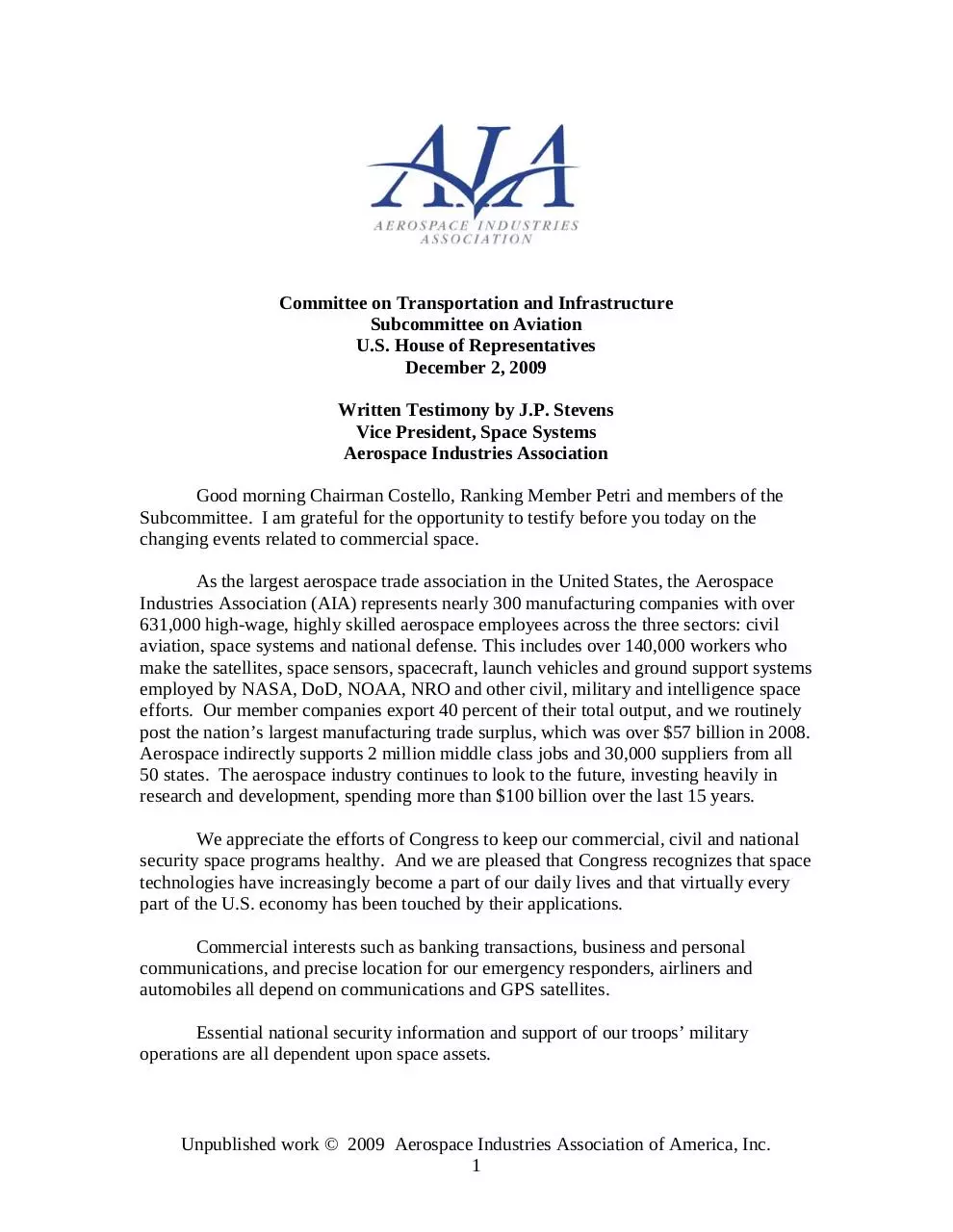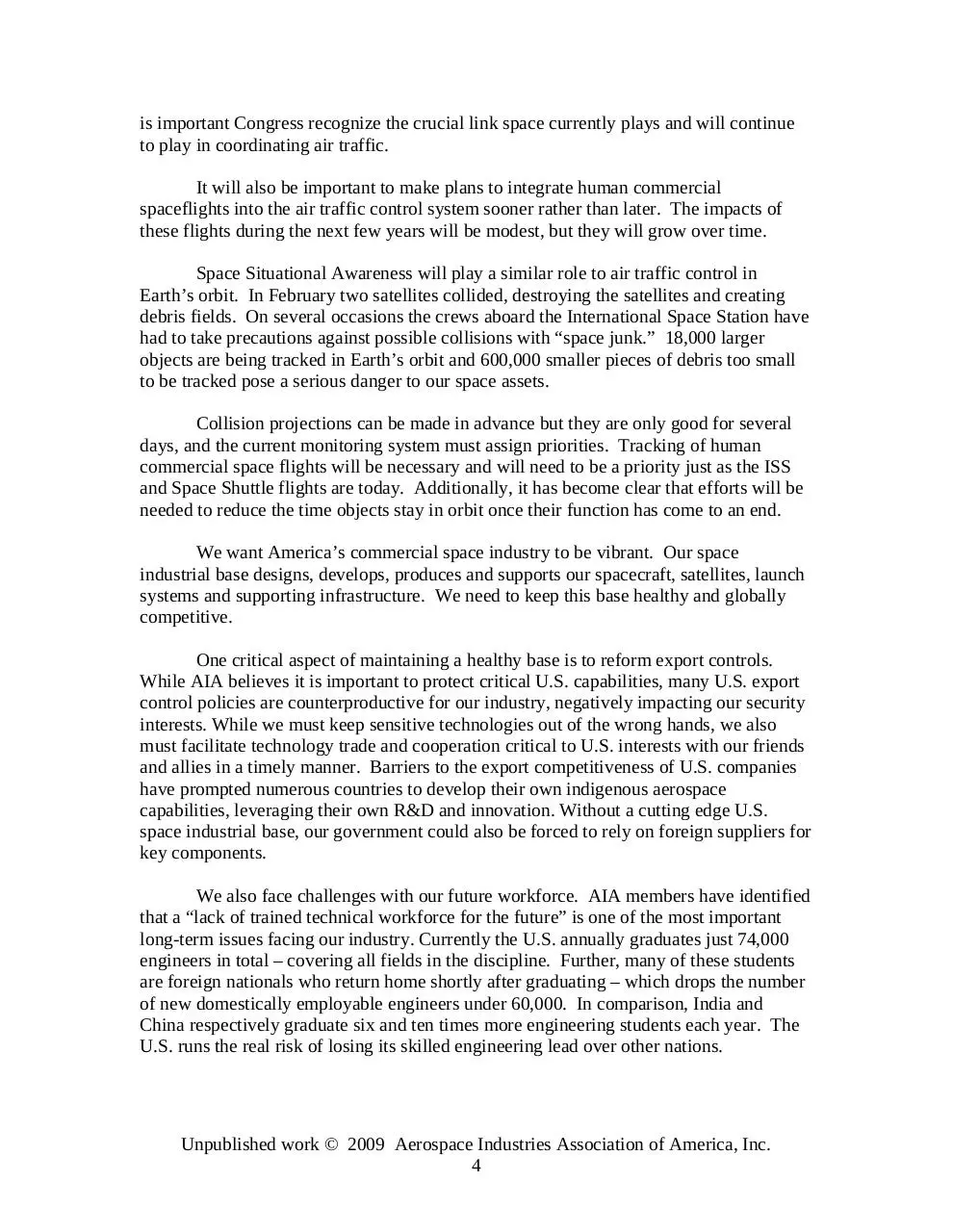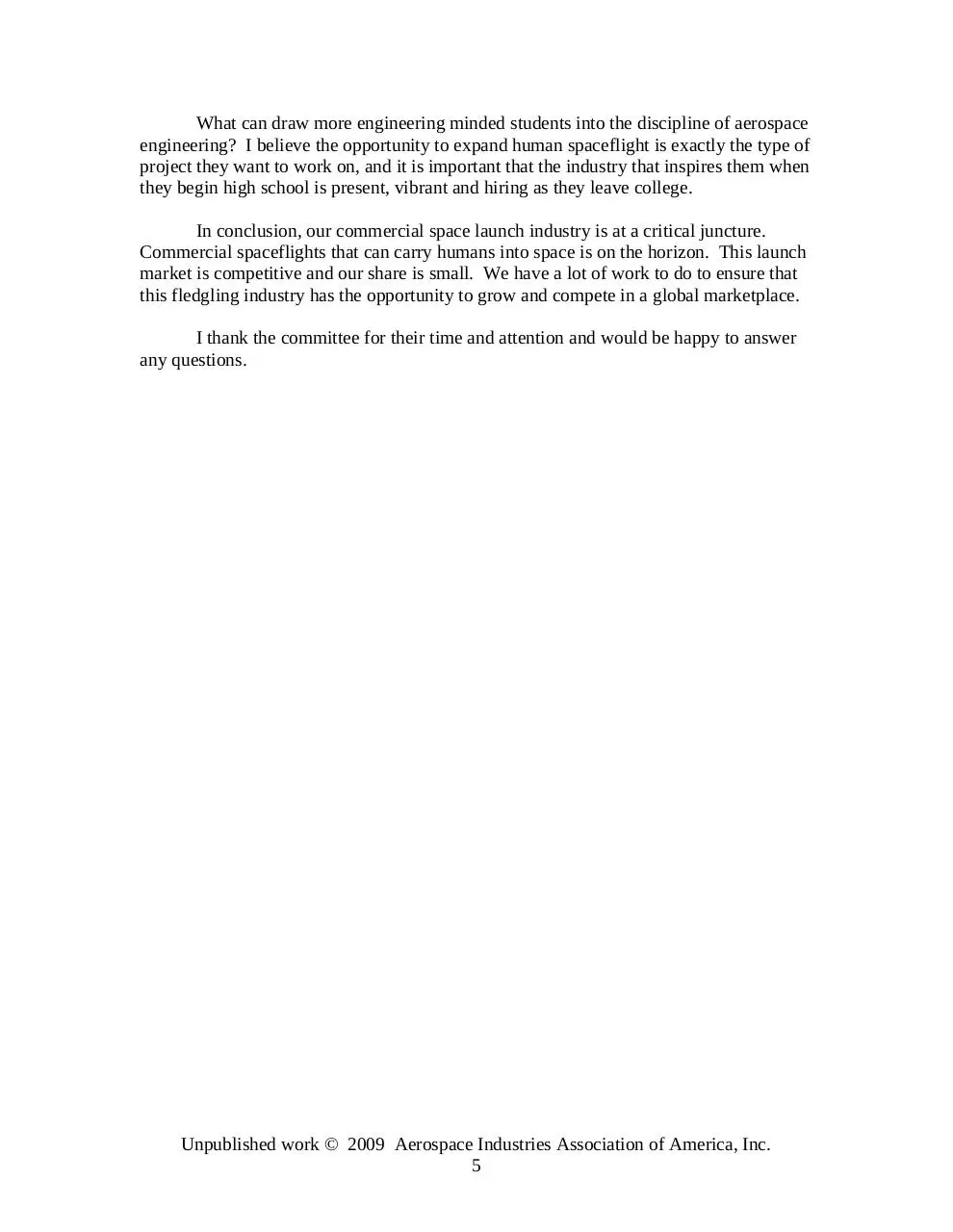AIA Cong Test T&I for Stevens (PDF)
File information
Title: Microsoft Word - testimony_12022009.doc
Author: patrick.carlson
This PDF 1.4 document has been generated by PScript5.dll Version 5.2.2 / Acrobat Distiller 8.0.0 (Windows), and has been sent on pdf-archive.com on 25/11/2017 at 17:26, from IP address 72.86.x.x.
The current document download page has been viewed 244 times.
File size: 32.3 KB (5 pages).
Privacy: public file





File preview
Committee on Transportation and Infrastructure
Subcommittee on Aviation
U.S. House of Representatives
December 2, 2009
Written Testimony by J.P. Stevens
Vice President, Space Systems
Aerospace Industries Association
Good morning Chairman Costello, Ranking Member Petri and members of the
Subcommittee. I am grateful for the opportunity to testify before you today on the
changing events related to commercial space.
As the largest aerospace trade association in the United States, the Aerospace
Industries Association (AIA) represents nearly 300 manufacturing companies with over
631,000 high-wage, highly skilled aerospace employees across the three sectors: civil
aviation, space systems and national defense. This includes over 140,000 workers who
make the satellites, space sensors, spacecraft, launch vehicles and ground support systems
employed by NASA, DoD, NOAA, NRO and other civil, military and intelligence space
efforts. Our member companies export 40 percent of their total output, and we routinely
post the nation’s largest manufacturing trade surplus, which was over $57 billion in 2008.
Aerospace indirectly supports 2 million middle class jobs and 30,000 suppliers from all
50 states. The aerospace industry continues to look to the future, investing heavily in
research and development, spending more than $100 billion over the last 15 years.
We appreciate the efforts of Congress to keep our commercial, civil and national
security space programs healthy. And we are pleased that Congress recognizes that space
technologies have increasingly become a part of our daily lives and that virtually every
part of the U.S. economy has been touched by their applications.
Commercial interests such as banking transactions, business and personal
communications, and precise location for our emergency responders, airliners and
automobiles all depend on communications and GPS satellites.
Essential national security information and support of our troops’ military
operations are all dependent upon space assets.
Unpublished work © 2009 Aerospace Industries Association of America, Inc.
1
Weather and climate satellites give us life saving warnings and provide us
recurring, global wide data on climate change.
Observing, monitoring and exploring space relies on incredibly robust equipment
functioning in extremely hostile and demanding environments.
Additionally our space programs, particularly NASA’s, remain an excellent
source of inspiration for our youth to study science, technology, engineering and
mathematics and to enter our aerospace workforce on which much of our nation’s
transportation, security and economic infrastructure depend. Certainly the exciting work
by private companies in expanding the availability of space flight is also a draw for
young people - one we hope will increase over the next few years.
We would also like to take this opportunity to commend the FAA’s Office of
Commercial Space Transportation, which has been very open to thoughtful discussion on
issues related to space launch. Their Commercial Space Transportation Advisory
Committee (COMSTAC) includes a wide range of industry experts who provide
information, advice and recommendations to the Administrator of the FAA on a regular
basis. The FAA also hosts an annual Commercial Space Transportation conference. The
aerospace industry has found both COMSTAC and the conference to be excellent venues
for sharing information and expressing concerns.
AIA believes the FAA has struck the right balance on a difficult issue: how to
properly regulate and oversee human commercial spaceflight. On one side of the balance
is the need to safeguard the participants and the public. On the other side, this industry is
very young and the systems and proceedures that fledgling companies are developing are
still taking shape. Keep in mind that with the success of SpaceShipOne in 2004, there
have been only three human rated commercial space flights to date. We believe the FAA
has found a good middle ground in their oversight.
In short, the human commercial launch industry is developing and taking shape.
The FAA has developed a sound set of regulations and understands that as this new part
of the space and launch industries evolve, the regulations will similarly need to evolve.
There are outside events that could increase and accelerate the FAA’s role in
licensing and oversight. As you know, the Review of U.S. Human Space Flight Plans
Committee, or Augustine Committee, recently provided the administration with a series
of options regarding NASA’s future direction. One option is continuing with the current
“program of record” and proceeding with the development of both the Ares-I human
rated launch system and a larger unmanned heavy lift vehicle which would launch
equipment bound for the moon. There are options considering different types of heavy
lift vehicles which could be human rated. But the committee also considered an approach
where commercial launch companies ferry astronauts to and from the International Space
Station, thus freeing NASA to focus on its Orion spacecraft flights beyond low Earth
orbit to the moon or other destinations of interest.
Unpublished work © 2009 Aerospace Industries Association of America, Inc.
2
The Space Shuttle is slated to retire after five more flights. At that time the U.S.
will face a human spaceflight “gap” of at least five years. Currently plans to transport
American astronauts to the ISS during this break in U.S. human space flight consist of
riding aboard the Russian Soyuz spacecraft. Augustine Committee options are currently
being considered by the administration. Depending on the response to the various
options set forth by the committee it is possible that along with licensing commercial
cargo flights to the ISS the FAA could see an accelerated effort for human commercial
carriage.
There are other issues related to commercial space launch that are of concern to
us, affecting both human flight and cargo payload delivery.
As space launch capabilities have been developed by other nations the U.S. share
of commercial launches has decreased significantly. In 2008 only 6 of the 28 worldwide
commercial launches were conducted by U.S. companies.
Every other nation with commercial space launch capabilities provides some form
of government indemnification against third-party liability. The current third party
indemnification regime in the U.S expires this December 31. Elimination of U.S.
government indemnification would drive even more launch business overseas and could
also impact launches of U.S. civil and national security payloads because the same
companies also launch under government contracts.
The current regime sets aside no funds and requires Congressional approval for
any payment, so continued indemnification imposes no additional costs to the U.S.
taxpayer. We are very pleased that the House recently extended this regime until the end
of 2012. It is our hope that the Senate will follow suit before the end of the year.
However, while a three year extension prevents the immediate end of this critical regime
it is not sufficient because launch manifests can extend out for several years.
Maintaining the regime helps provide a level playing field and strengthens U.S.
international competitiveness in a very competitive global space launch market. For our
companies it maintains continuity in the business environment. It encourages new entries
by U.S. companies into the launch market.
A Congressionally-mandated FAA study of the subject was conducted by The
Aerospace Corporation. They and COMSTAC both have endorsed the continuation of
the regime. AIA believes the indemnification of U.S. commercial space launch should be
made permanent, and the $1.5 billion tier 2 cap should be lifted.
Space will play a critical role in the infrastructure of the Next Generation Air
Transportation System (NextGen). It will surprise no one on this committee that while
the aerospace industry is building 21st century aircraft, they navigate our skies using a
system that largely dates back to the 1960s. The role of satellites to NextGen, for
communication and GPS position, navigation and timing will be a critical component. It
Unpublished work © 2009 Aerospace Industries Association of America, Inc.
3
is important Congress recognize the crucial link space currently plays and will continue
to play in coordinating air traffic.
It will also be important to make plans to integrate human commercial
spaceflights into the air traffic control system sooner rather than later. The impacts of
these flights during the next few years will be modest, but they will grow over time.
Space Situational Awareness will play a similar role to air traffic control in
Earth’s orbit. In February two satellites collided, destroying the satellites and creating
debris fields. On several occasions the crews aboard the International Space Station have
had to take precautions against possible collisions with “space junk.” 18,000 larger
objects are being tracked in Earth’s orbit and 600,000 smaller pieces of debris too small
to be tracked pose a serious danger to our space assets.
Collision projections can be made in advance but they are only good for several
days, and the current monitoring system must assign priorities. Tracking of human
commercial space flights will be necessary and will need to be a priority just as the ISS
and Space Shuttle flights are today. Additionally, it has become clear that efforts will be
needed to reduce the time objects stay in orbit once their function has come to an end.
We want America’s commercial space industry to be vibrant. Our space
industrial base designs, develops, produces and supports our spacecraft, satellites, launch
systems and supporting infrastructure. We need to keep this base healthy and globally
competitive.
One critical aspect of maintaining a healthy base is to reform export controls.
While AIA believes it is important to protect critical U.S. capabilities, many U.S. export
control policies are counterproductive for our industry, negatively impacting our security
interests. While we must keep sensitive technologies out of the wrong hands, we also
must facilitate technology trade and cooperation critical to U.S. interests with our friends
and allies in a timely manner. Barriers to the export competitiveness of U.S. companies
have prompted numerous countries to develop their own indigenous aerospace
capabilities, leveraging their own R&D and innovation. Without a cutting edge U.S.
space industrial base, our government could also be forced to rely on foreign suppliers for
key components.
We also face challenges with our future workforce. AIA members have identified
that a “lack of trained technical workforce for the future” is one of the most important
long-term issues facing our industry. Currently the U.S. annually graduates just 74,000
engineers in total – covering all fields in the discipline. Further, many of these students
are foreign nationals who return home shortly after graduating – which drops the number
of new domestically employable engineers under 60,000. In comparison, India and
China respectively graduate six and ten times more engineering students each year. The
U.S. runs the real risk of losing its skilled engineering lead over other nations.
Unpublished work © 2009 Aerospace Industries Association of America, Inc.
4
What can draw more engineering minded students into the discipline of aerospace
engineering? I believe the opportunity to expand human spaceflight is exactly the type of
project they want to work on, and it is important that the industry that inspires them when
they begin high school is present, vibrant and hiring as they leave college.
In conclusion, our commercial space launch industry is at a critical juncture.
Commercial spaceflights that can carry humans into space is on the horizon. This launch
market is competitive and our share is small. We have a lot of work to do to ensure that
this fledgling industry has the opportunity to grow and compete in a global marketplace.
I thank the committee for their time and attention and would be happy to answer
any questions.
Unpublished work © 2009 Aerospace Industries Association of America, Inc.
5
Download AIA Cong Test T&I for Stevens
AIA Cong Test T&I for Stevens.pdf (PDF, 32.3 KB)
Download PDF
Share this file on social networks
Link to this page
Permanent link
Use the permanent link to the download page to share your document on Facebook, Twitter, LinkedIn, or directly with a contact by e-Mail, Messenger, Whatsapp, Line..
Short link
Use the short link to share your document on Twitter or by text message (SMS)
HTML Code
Copy the following HTML code to share your document on a Website or Blog
QR Code to this page

This file has been shared publicly by a user of PDF Archive.
Document ID: 0000701310.